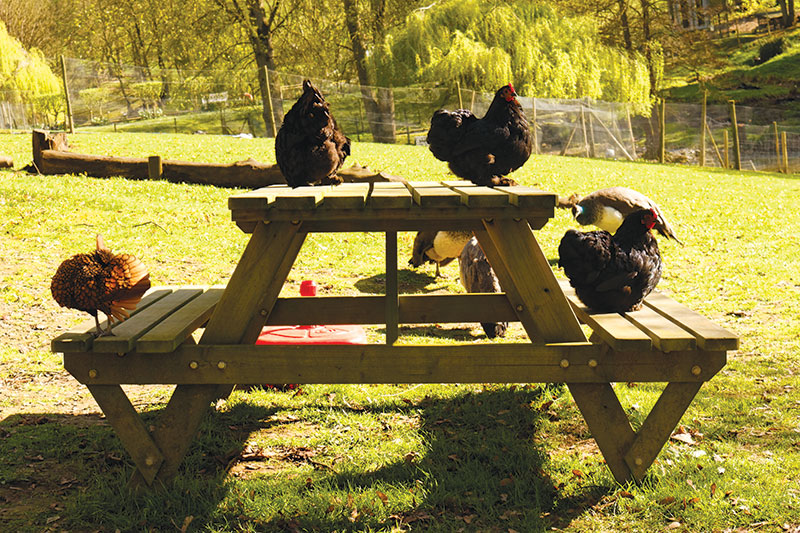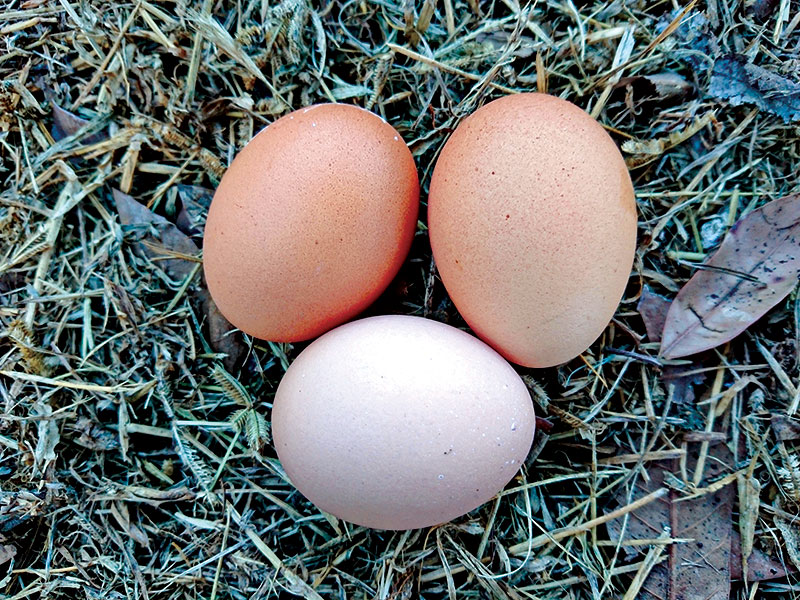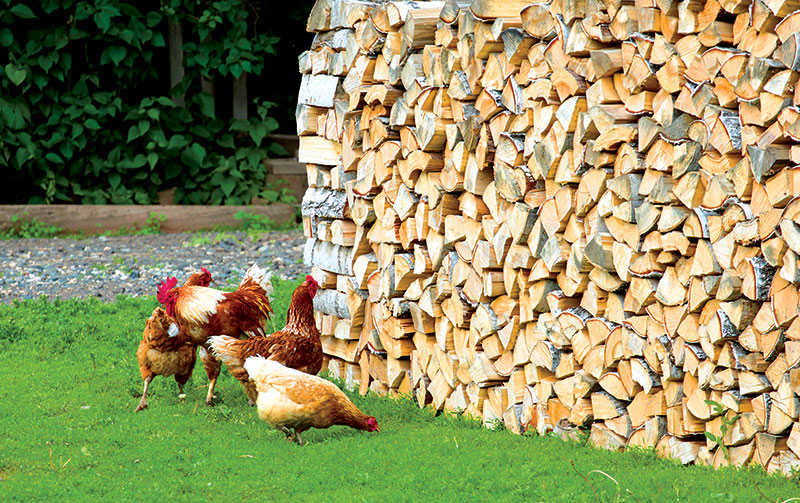
Do you dream of picturesque grassy fields dotted with free-range chickens? Are you ready to reduce your organic chicken feed bill? Do you want to set your chickens free and enjoy the benefits of truly free-range eggs? It can be done. Free-range chickens are among the healthiest and happiest of chickens, and they produce amazingly nutritious eggs. Plus, they have no rivals when it comes to simplicity.
The term “free-range” describes a method of farming that allows animals to roam free outdoors. The term is often loosely applied when it comes to egg carton labels. A true free-range bird, however, is allowed to roam without the boundary of interior fences. A free-range chicken is a rare breed but arguably the best chicken to keep, raise and provide breakfast. Free-ranging does more than provide healthy chickens and eggs, though; it provides a healthier setting for the chicken keepers and the environment. To properly keep them, you need only a nighttime coop and plenty of space.
A Higher Place
In order to remain healthy, a chicken needs exercise, a healthy living environment, plenty of fresh water and a nutritious diet. The free-range bird gets it all.
Foraging for meals does more than produce healthy eggs. Free-range chickens get more exercise and sunlight and are generally happier. A hen that is allowed to spend her day roaming the fields and wood lines searching for her next grub or treat is a happy hen. Observe a few chickens for a short time, and you’ll undoubtedly see how much they enjoy the “hunt.” Scratching and pecking are more than just a pastime; it’s what chickens do. A mother hen wastes no time before teaching her brood of chicks the art of scratching out a living.
Free-range chickens get a lot of exercise, so weight is rarely a problem. When chickens are fed too many treats and don’t get enough exercise, it can result in health issues. Chickens that roam free typically burn more calories on their quests for food and snacks, keeping them svelte and fit.
A chicken’s nutritional requirements are also simplified with free-ranging. With an accommodating landscape at her beak, a hen will naturally consume a healthy diet. A chicken’s native sustenance consists of berries, seeds, insects, grubs and greens. These naturally sourced foods provide the carbohydrates, oil, protein, vitamins and minerals the chicken needs.
Breakdown
Farmers have paired chickens and cows together for years for sustainable agriculture. When this duo is allowed to coexist, the farm, the animals and the environment benefit: Cows keep the grasses mowed down so the chickens can get to all the bugs and seeds, and the cows “feed” the chickens for free, as chickens love breaking down and scratching through cow pies.
An amazing amount of nutrition can be scavenged from cow droppings: undigested grain, seeds, maggots, grubs and even bits of manure. As unappetizing as it sounds, manure provides many essential vitamins and other nutrients to the chicken.
“There is a benefit to keeping chickens and cows together or to allowing chickens to forage on pastures previously used by cows,” notes Jacquie Jacob, poultry extension project manager at the University of Kentucky in “Interactions of Chickens in Small and Backyard Poultry Flocks with Other Species.”
“The chickens will eat any feed that the cows have dropped and will peck through cow manure looking for larvae. A cattle-chicken rotational system is good for reducing fly problems.”
This team is also great for the pastures because the chickens scatter the cow pies, allowing the manure to compost more quickly and easily into the earth. This prevents dead spots, reduces diseases and controls bug populations. Perhaps one of the best ways to keep the flies off the farm is to get a flock of free-range chickens.
Learning to Fly
Free-range chickens also are beneficial for farmers and farms. Because the chicken is allowed to scour the land for food, it will consume less commercial chicken feed, especially in lush landscapes flourishing with chicken delicacies. This can save the farmer substantial amounts of money. During most seasons in moderate climates, a chicken with the freedom to explore can be quite resourceful. There are plenty of edible feasts found on homesteads everywhere. The pastures, the ground under rabbit hutches, pig pens, gardens, compost bins and even the barn floor provide meals to the unrestricted chicken.
The chicken keeper can save money on grit as well with free-ranging. Because chickens don’t have teeth, they rely on their gizzard and a bit of grit to “chew” their food. In most circumstances, free-ranging chickens gather all the grit they need from the wild. Bits of rock, sand and rubble will make their way into the chicken’s diet naturally.
Ultimately, a healthier chicken means healthier eggs for the farmer to consume and sell. The diet of the free-range chickens is fresher, more organic and less processed. Just like humans, chickens are healthier when they eat a fresh, raw, natural diet. Likewise, the eggs from these free-range flocks pack more nutrition than those of their confined counterparts. A free-range chicken egg has a yolk that glows with nutritional supremacy. The bright-orange color isn’t a sign of freshness; it’s a sign of excellent nutritional value within the egg and a sign of a healthy hen.
Another benefit of keeping free-range chickens is the simplicity of this farming method. No fences must be erected. No gates need to be hung. No runs, birdcages or chicken tractors are needed. The only necessity of the free-range chicken is its home. By keeping chickens free, the amount of space necessary inside the coop is also reduced. When chickens are allowed to roam free, they need only enough space on the roosting bars to comfortably sleep at night, at least 8 inches of roosting bar per bird.
Free Falling
Free-range chickens are also great for the environment and cause less pressure on land. With free-ranging, the chicken keeper never faces the problem of a desolate, disgusting chicken run. When chickens are penned in, it’s only a matter of time before they have their way with the area. It happens all the time. A well-intentioned, egg-loving soul decides to raise a few laying hens. She fences off a beautiful chicken space in the corner of the yard and puts up a coop.
Before much time passes, the pretty, green yard is transformed into a desert, void of all life. Inevitably, nothing remains to scratch and peck, leaving the chickens to rely solely on their keeper—and usually a bag of feed—for sustenance.
This is never the destiny of the free-range bird. The world is her buffet, and as long as she is up for the hunt, the food is there for the taking. Because free chickens are not concentrated to one section of the land, the landscape doesn’t suffer from too much pressure.
Farmers can also reduce the insect and bug populations on their property with free-ranging. Chickens are excellent exterminators. They eat just about any insect or bug. Chickens enjoy ticks, creepy-crawly bugs and even eat the fly larvae out of manure.
Here Come My Girls
Getting started with a flock of free-range chickens is easy. Start by choosing the right real estate for the flock’s new abode. When deciding where to erect the chicken coop, consider the following.
First and foremost, the location should be a safe one. Thick, wooded areas or wood lines might not be the ideal location for the chicken coop. Although tree cover can provide some protection from overhead predators, such as hawks, the woods are often home to many other predators seeking a chicken dinner. A vulnerable flock of hens is often safer with the coop in a field or other open space with only a few trees.
Once you’ve selected the location, you can move the birds to their new home. Free-range chickens must be trained to come home to roost at night. This is a simple process that begins with “chicken camp.” After the chickens are old enough to be free from a brooder, they can be safely welcomed to the coop.
Begin by confining the chickens to the coop for a few days. During this time, you’ll need to provide a high-quality chicken feed and plenty of fresh water inside the coop. Refill the food and water each day. To train a flock of chickens to come when called, simply say “here-chick-chick-chick” each time food is replenished. They will quickly learn that this call means dinner, and they’ll come running when they hear it.
After about four days, open the chicken door and let the chickens come out at their own pace. They will return to their home through the same door each day at sundown. For the first days or weeks, the chickens will probably stay close to their home. Before long, they will adventure over the hills and through the barns looking for good things to eat.
Timid chickens can be encouraged to free-range. Lead the flock to the areas that contain some good chicken snacks and simply sprinkle down a little feed. You can also encourage chickens to free-range by offering a variety of foods. Chickens that eat only commercial feed might not recognize greens or seeds as food. Providing healthy kitchen scraps or garden scraps to chickens regularly opens their eyes to new and delicious chow. The more experience a flock of chickens has with free-ranging, the more proficient it becomes.
Keep watch over the chickens and offer free-choice feed as needed to supplement their diet. The free-range chicken soon learns where to find the best meals and probably starts to ignore the store-bought feed, greatly reducing your feed bills and producing a happy farmer.
If removing all the chicken tractors, runs and fences seems irresponsible and risky, just relax. Free-range chickens might be some of the safest of chickens. Because they are constantly on the hunt for nutrients, they are usually healthier, slimmer and more energetic. This makes the escape from a hungry predator far more likely.
Additionally, with the freedom to forage also comes the freedom to evade predators. Many attacks on chickens happen right in their homes or runs. Being trapped in a run can also mean having no way to escape a hungry varmint.
You’re So Bad
Predators can pose a real risk to free-ranging situations, suggests Terry E. Poole, principal agent emeritus at the University of Maryland Extension, in “Introduction to Developing a Free-Range Poultry Enterprise.”
Building an effective perimeter fence around your property is a good start. Poole states that the fence should be at least 6 feet high and have a small enough mesh that predators cannot squeeze through. He also recommends that the perimeter fence be buried at least 6 inches in the soil to prevent predators from digging underneath. Electric wire can be added near the base of the fence to stop diggers and at the top to prevent predators from climbing over the fence.
“Another good preventative practice is to keep pastures mowed or grazed down,” Poole says. “This practice eliminates much of the cover preferred by predators that are more comfortable approaching prey unseen in the tall grass.”
Free-ranging, like other chicken-keeping methods, is not perfect; however, it does provide a great life for chicken and chicken keeper alike, and it’s better for the environment. Free-range chickens live healthier, happier lives filled with fresh, real foods.
The free-range method is simple to embrace and put into action. It undeniably provides the tastiest, most nutritious eggs and meat on the planet while allowing chickens to fulfill their destiny as hunters and peckers.
This story originally appeared in the May/June 2018 issue of Chickens magazine.




